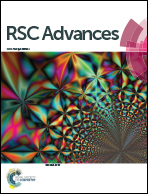Facile synthesis of carbon and oxygen vacancy co-modified TiNb6O17 as an anode material for lithium-ion batteries†
Abstract
Titanium niobium oxides (TNOs), benefitting from their large specific capacity and Wadsley–Roth shear structure, are competitive anode materials for high-energy density and high-rate lithium-ion batteries. Herein, carbon and oxygen vacancy co-modified TiNb6O17 (A-TNO) was synthesized through a facile sol–gel reaction with subsequent heat treatment and ball-milling. Characterizations indicated that A-TNO is composed of nanosized primary particles, and the carbon content is about 0.7 wt%. The nanoparticles increase the contact area of the electrode and electrolyte and shorten the lithium-ion diffusion distance. The carbon and oxygen vacancies decrease the charge transfer resistance and enhance the Li-ion diffusion coefficient of the obtained anode material. As a result of these advantages, A-TNO exhibits excellent rate performance (208 and 177 mA h g−1 at 10C and 20C, respectively). This work reveals that A-TNO possesses good electrochemical performance and has a facile preparation process, thus A-TNO is believed to be a potential anode material for large-scale applications.



 Please wait while we load your content...
Please wait while we load your content...